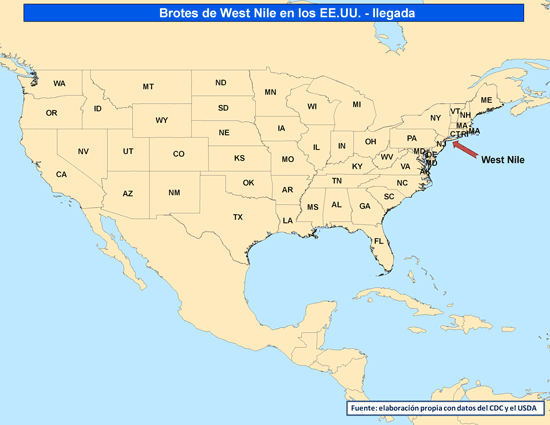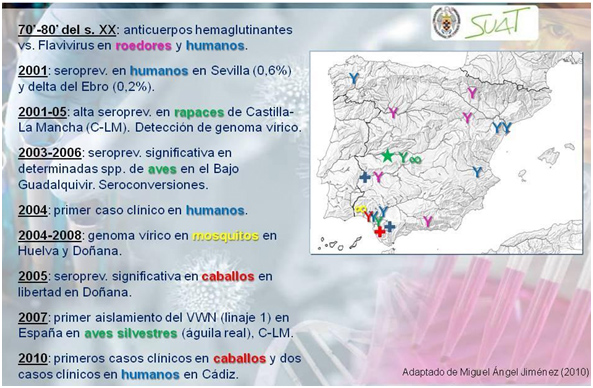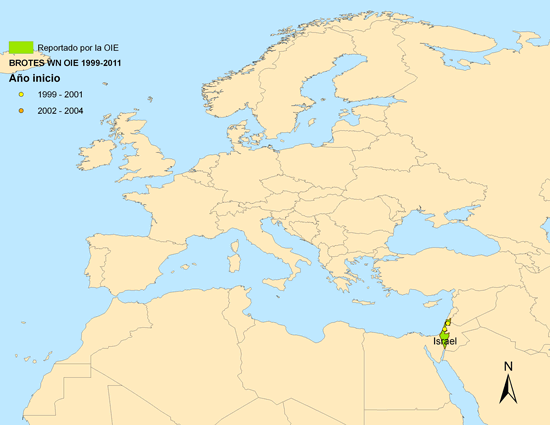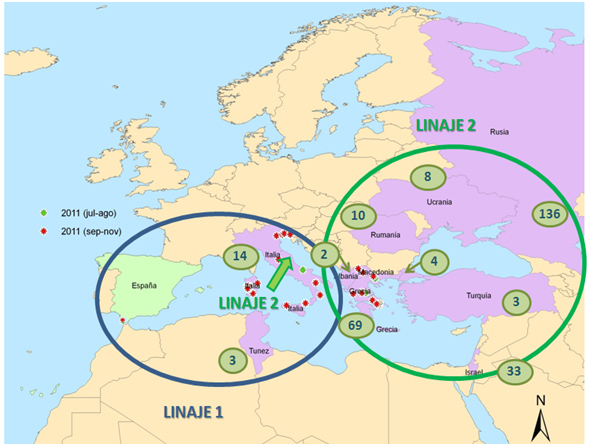West Nile (WN)
West Nile disease (WN) is a notifiable non-contagious infectious disease caused by a flavivirus. In the last years it has become especially relevant in Europe because of its reemergence, particularly in the countries of the Mediterranean basin. This disease is vectorial, involving mainly mosquitoes of the genus Culex, and affects a wide range of hosts, especially birds (considered to be amplifying hosts), equines and humans (both considered to be dead-end hosts). In equines, this virus is usually associated with a subclinical infection, although a small percentage may suffer from neurological symptoms, or even a severe encephalomielitisleading to the death of animals. In Spain, the virus started to cause outbreaks in 2010 in several farms in southern Andalusia; in 2011 the number of cases increased. Furthermore, a lineage distinct (lineage 2) from the one currently circulating in our country (lineage 1) has been spreading from eastern Europe, causing outbreaks of higher virulence affecting a large number of birds, horses and even humans. Global warming is having a direct influence on the distribution and survival of vectors, which leads to enhance surveillance and control measures against this disease that is exacerbating each new season.
History
West Nile (WN) is a notifiable vector-borne and worldwide distributed zoonotic disease caused by the WN virus (WNV). It is considered to be the most widely spread arbovirus in the world, since this flavivirus can replicate in a great number of bird, reptile, amphibian and mammal species, and has been isolated in at least 75 species of mosquitoes. In fact, it has being present in all the continents, except the Antarctic. Despite this widespread presence, clinical disease has been reported only in few species, mainly humans, equidae and many species of birds. However, the role of these hosts in the WN epidemiology is quite different. Many birds have been reported to act as WNV reservoirs, amplifying the virus and spread by bird-vector-bird transmission (sylvatic cycle). Conversely, humans and equines may present severe clinical symptoms but are “dead-end” or incidental hosts, as they are not known to develop an infectious-level viraemia.
The virus was first isolated in 1937 in Uganda, in the West Nile district, from a woman who suffered from a mild fever. Due to the antigenic relationships with the virus of the St. Louis disease and Japanese encephalitis, the WNV was classified as an arbovirus of group B in 1954. During the following years sporadic isolated cases were identified in Africa, Middle East and southern Europe, which were given little importance. However, in the 1990s there were two events that highlight WN: the increase of highly virulent outbreaks associated with WNV in humans and horses since 1994 and the arrival of the virus in 1999 to U.S. associated firstly with an increased mortality in corvids, affecting in just 3 years a very large number of humans and horses and arriving the Pacific coast (Figure 1).

Fig. 1: Evolution of West Nile virus infection in the United States since its arrival in 1999 until 2004, and review of the epidemiological data up to date (Source: self elaboration from CDC and USDA data; last update: 16 February 2012).
During these years, outbreaks of WN were notified in several countries of the European and Mediterranean environment in horses and/or humans, including Algeria (1994), Morocco (1996-2003), Romania (1996-2000), Tunisia (1997), Russia (1999), Italy (1998), Israel (1998-1999, 2000), France (2000) and Sudan (2004). Of these, the most important ones were the outbreaks of Bucharest in 1996 (causing 393 hospitalised cases with 17 deaths) and Volgograd in Russia in 1999 (with 826 hospitalizations and 40 deaths). Furthermore, the outbreak of Israel in 1999 affected a huge number of geese and storks, so the role of migratory birds in the epidemiology of the disease was suspected. In fact, the three geographical settings are important stop-over places for birds in their migratory routes. Moreover, most of these outbreaks occurred in urban settings, where it is easy to find any place with stagnant water, Culex pipiens favourite place for breeding and development.

Fig. 2: Evolution of laboratory findings on West Nile virus infection in Spain [source: self elaboration based on scientific review and adaptation of image from Jiménez-Clavero (2010)]
In Spain, although virus circulation is suspected since 1979, during those years the virus could only be found in a man hospitalized with aseptic meningitis in Badajoz in 2004 (Figure 2). During 2003-2006, studies conducted in the surroundings of Doñana National Park, the Ebro delta and Castile-La Mancha suggested WNV circulation (or other related flavivirus), since antibodies were found in several species of birds, horses and mosquitoes (Figure 2). Until 2007 there was no virus isolation, when the virus was found in two golden eagles and one Bonelli’s eagle in Castile-La Mancha, isolates belonging to lineage 1 (Figure 2).
Current situation
Since 2004, West Nile (WN) outbreaks have been emerging in several countries of the Mediterranean basin. Outbreaks have been reported to the OIE in France (2004-2006), Italy (2008-2009, 2010-2011), Morocco (2010), Spain (2010-2011), Portugal (2010), Greece (2010 -2011), Bulgary (2010), Romania (2010) and Macedonia (2011).

Fig. 3: Evolution of infection with West Nile virus in Europe and the Mediterranean basin from 1999 to 2011. (Source: self elaboration from data obtained from the WAHID-OIE).
In the European Union (EU) in 2011, only equine sectors of Greece, Italy and Spain have been affected by WN virus, as well as Macedonia (Figure 2). The epidemiological wave of this year has brought 125 new WN outbreaks, affecting 186 horses among the four countries (with an apparent morbidity of 15.2%) and 10 outbreaks in birds in Macedonia (36 cases, 18.65% morbidity) ( Figure 1). However, two distinct lineages were identified to be responsible for the outbreaks, the lineage 1 and lineage 2. Lineage 1 is the most spread worldwide. Within lineage 1, clade 1a members are the most widely distributed, detected in Europe, Asia, Middle East and North Africa, as well as the only currently present in America. This is the virus that has been causing outbreaks in 2010 and 2011 in Spain, officially affecting 51 horses in 38 farms in Andalusia. The surveillance plan is currently being carried out to determine the circulation of the virus in our country and make time measures that curb.
On the other hand, lineage 2 was traditionally isolated only in sub-Saharan Africa and Madagascar. However, in recent years it has caused highly virulent outbreaks in Central and Eastern Europe and more recently in horses in Greece, Italy and Macedonia, in the latter also affecting birds. This lineage is characterized by causing outbreaks of substantial relevance in humans (Figure 2).

Fig. 4. Map showing the foci of the West Nile disease reported to the OIE in 2011, both in the EU (between January 1 and December 9, 2011) and Macedonia (between 29 September and on November 10, 2011). The green and red dots show the foci of WN in the periods from July to August and September to December, respectively. The green circles show the number of WN cases occurred in humans between July 26 and November 24, 2011 for each concerned country (in pink) (Source: World Organization for Animal Health, 2011; European Centre of Disease Prevention and Control, 2011).
The likelihood of introduction of the WN lineage 2 in Spain cannot be ruled out, although the outbreaks in the European Union (EU) are well controlled, have not affected a high number of animals, and even many animals are vaccinated against it. However, this introduction could lead to serious consequences, given its high virulence and the failure to protect susceptible hosts against this lineage. The introduction of this virus in Spain could be originated by various routes of transmission, among which migrations of birds, live bird trade, and movement of the vectors through the wind or fomites.
Currently, many national equine farms are being vaccinated against WN virus with the Duvaxyn® WNV vaccine (Fort Dodge) that is made with a strain of lineage 1. The vaccine does not guarantee 100% protection against all strains of lineage 1 (especially against the most antigenically evolved strains). Given that there are major antigenic differences between lineages 1 and 2, if lineage entered Spain vaccination would not offer complete protection against it. Although studies conducted in mice have shown good protection of the vaccine made with the lineage 1 against infection with lineage 2, up to date there are no scientific data from trials conducted in horses. Therefore, we believe it would be appropriate to conduct studies in horses to prove protection of the vaccine made with lineage 1 against lineage 2 strains and / or to encourage the development of a new bivalent vaccine.
At present, it is considered that the season for WN virus transmission is finished in the European Union, mainly due to the drastic decline in vector populations. However, the situation of lineage 2 in horses and birds in the affected countries of the EU has to be monitored, since an increase of virus circulation could favor its introduction in our country, especially through migration of birds and / or through the transport of vectors by fomites. Thus, it would be advisable to increase surveillance measures in Spain to quickly and effectively detect and control any possible incursion of this lineage in our country.


